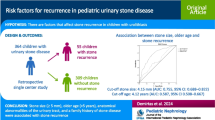Abstract
Objective
To evaluate the natural course of the stone disease in pediatric patients from different perspectives among which the spontaneous passage and stone recurrence rates evaluated during the follow-up.
Materials and methods
A total of 142 children referring with primary urinary stone disease were evaluated and followed. All children in the study were divided into two groups with respect to the age (Group 1: 0–5 years and Group 2: 6–15 years). Children were followed with respect to spontaneous passage rates, recurrence-regrowth rates, physical as well as the renal growth rates.
Results
Stone recurrence has been noted in 44% of patients in group 1, this value was 31% in group 2. Children with at least one identifiable metabolic abnormality tended to have higher recurrence rates than the others despite conservative measures. The average stone recurrence rate in children without any metabolic abnormality was 14% and nearly 50% in children with an identifiable metabolic abnormality.
Conclusions
We may emphasize that due to the high recurrence and re-growth rates, all children with urinary stone disease should be followed closely with regular visits. The evaluation of metabolic risk factors in children with renal stone disease is the basis of medical treatment aimed at preventing recurrent stone events and the growth of pre-existing calculi.
Similar content being viewed by others
References
Faerber GJ (2001) Pediatric urolithiasis. Urology 11:385–389
Spivacow FR, Negri AL, Del Valle EE et al (2008) Metabolic risk factors in children with kidney stone disease. Pediatr Nephrol 23:1129–1133
Gurocak S, Kupeli B, Acar C et al (2008) The impact of pelvicaliceal features on problematic lower pole stone clearance in different age groups. Int Urol Nephrol 40(1):31–37
Sarica K (2006) Pediatric urolithiasis: etiology, specific pathogenesis and medical treatment. Urol Res 34:96–101
Hoppe B, Jahnen A, Bach D et al (1997) Urinary calcium oxalate saturation in healthy infants and children. J Urol 158:557–559
Kroovand RL (1997) Pediatric urolithiasis. Urol Clin North Am 24:173–185
Cohen TD, Ehreth J, King LR et al (1996) Pediatric urolithiasis: medical and surgical management. Urology 47:292–305
Erbagcı A, Erbagcı BA, Yılmaz M et al (2003) Pediatric urolithiasis. Scand J Urol Nephrol 37:127–133
Pietrow PK, Pope JC, Adams MC et al (2002) Clinical outcome of pediatric stone disease. J Urol 167:670–673
Milliner DS, Murphy ME (1993) Urolithiasis in pediatric patients. Mayo Clin Proc 68:241–244
Noe HN (2000) Hypercalciuria and pediatric stone recurrences with and without structural abnormalities. J Urol 164:1094–1096
Bak M, Ural R, Agin H et al (2009) The metabolic etiology of urolithiasis in Turkish children. Int Urol Nephrol 41:453–460
Goaling P (1986) Analytical reviews in clinical biochemistry: calcium measurement. Ann Clin Bichem 23:146–149
Krieg M, Gunsser KJ, Steinhagen-Tessen E et al (1986) Comparative quantitative clinico-chemical analyses of the characteristics of 24-hour urine and morning urine. J Clin Chem Clin Biochem 24:863–866
Konuş OL, Ozdemir A, Akkaya A et al (1998) Normal liver, spleen and kidney dimensions in neonates, infants and children: evaluation with sonography. Am J Roentgenol 171:1693–1698
Sarica K (2008) Medical aspect and minimal invasive treatment of urinary stones in children. Arch Ital Urol Androl 80:43–49
Stapleton B (1996) Clinical approach to children with urolithiasis. Semin Urol 16:389–397
Pak CYC, Fuller C, Sakhaee K (1985) Long-term treatment of calcium nephrolithiasis with potassium citrate. J Urol 134:11–14
Rizvi SAH, Naqvi SAA, Hussain Z et al (2002) Pediatric urolithiasis: developing nation perspectives. J Urol 168:1522–1525
Coe FL, Favus MJ (1986) Disorders of stone formation in the kidney, 3rd edn. Philadelphia7, WB Saunders, pp 1403–1442
Polinsky MS, Kaiser BA, Baluarte HJ (1987) Urolithiasis in childhood. Pediatr Clin North Am 34:683–710
Dursun I, Poyrazoglu H, Dusunsel R et al (2008) Pediatric urolithiasis: an 8-year experience of single centre. Int Urol Nephrol 40:3–9
Tabel Y, Akın IM, Tekin S (2009) Clinical and demographic characteristics of children with urolithiasis: single-center experience from eastern Turkey. Int Urol Nephrol 83(2):217–221
Schwarz RD, Dwyer NT (2006) Pediatric kidney stones: long-Term outcomes. Urology 67:812–816
Kalorin CM, Zabinski A, Okpareke I et al (2009) Pediatric urinary stone disease: does age matter? J Urol 181:2267–2271
Author information
Authors and Affiliations
Corresponding author
Rights and permissions
About this article
Cite this article
Koyuncu, H., Yencilek, F., Erturhan, S. et al. Clinical course of pediatric urolithiasis: follow-up data in a long-term basis. Int Urol Nephrol 43, 7–13 (2011). https://doi.org/10.1007/s11255-010-9791-y
Received:
Accepted:
Published:
Issue Date:
DOI: https://doi.org/10.1007/s11255-010-9791-y




